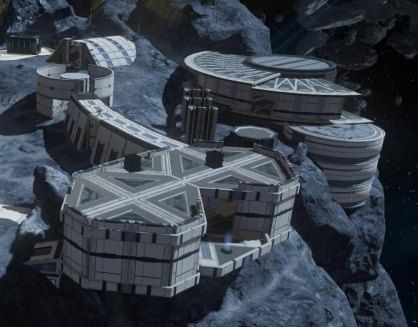When I discuss cohesion, I usually refer to the cohesion of the Architectural Theme or the Architectural design, because that is where forgers tend to have the greatest difficulty in bringing forth strong cohesion. Either they have none, or their Architecture is missing it here or there and thus it simply breaks down.
There are a number of factors that can break cohesion of a map’s Architecture. I will try to list some of them here, but by no means are these the only ones.
Visual Noise
No map can sustain cohesion in any sense of the word if there is visual noise. Visual noise is where you look and see lot of colors, contrast, and patterns that don’t create any kind of unity in Architecture. Halo 4’s palettes are notorious for blocks’ skins that contribute heavily to visual noise.Consider the types of blocks that you use to build a single structure. Do they look like they go together? Do they look like they form a cohesive structural feature? This is the most difficult part right here, so let me say it again. Do the pieces that make a structure look like they work with each other? Or do they clash with each other, creating visual noise?
Clashing Architecture
Consider two structures that have distinct Architectures, yet they are sitting next to each other, or facing each other. If they look vastly different, they clash. Consider the types of blocks that they use in their construction. How would one structure made up of Brace Larges look compare to another sitting next to it made of 4×4 talls?The following picture shows a collection of experimental Architecture that I was developing to see what I would be able to use effectively. Notice how they clash with each other due to their Geometries and skins.

Consider every publisher map you have ever played on. There are very few that have varying Architectural features through out the map (e.g., Powerhouse). Typically, the Architectural features are common everywhere you go. Consider the white walls and balconies of Boardwalk, the redwood flooring and walls through out Reflection, the grey steal structures through out Countdown, the grassy hills of Valhalla and the two silver grey forerunner structures at either end, the sand dunes and rock structures through out Sand Trap, the green quarts/metallic through out Guardian, the violet alien gentle curved structures through out Assembly and Zealot, the grey slate slanted walls through out Sword Base, the circular structures throughout Spire. Geometry helps maintain cohesion through out the map by bringing unity of Architecture.
Bringing Cohesion To Your Map
If one structure in your map is circular, make them all circular (Hekau). If one is elongated rectangular, make them all like that (Boardwalk, Sword Base, Reflection). If one is tall and narrow, try to make them all similar in ratio of height to width (Orbital, Narrows, Valhalla). If one is elevated off the ground, try to make them all elevated in the same way, but perhaps a little different elevation for each so that they are not on the same plane (Boneyard). If one is boxy, try to make everything about your map boxy (The Pit).If your map has a weenie in the center, then try to make the rest of the map similar in elevation according to their distance from the weenie (Spire, Zealot). If your map is an asymmetrical map, consider a steady change in elevation from one end to the other (High Ground, Powerhouse, Zanzibar).
Try to make the doorways look the same through out. This makes the cohesion of the structures even stronger, because the doorways are a key element that players focus on, and they will see how the doors differ even the slightest. This doesn’t mean that the doors have to be the same exact dimensions, but that they look like they were constructed with similar architecture with similar materials for trim, walls, etc.
Leverage the natural terrain and make the structures you forge on the terrain match the terrain in the context of the Theme you are trying to forge into your map. And when I say Theme, it can be abstract Art for all I care. It just needs to be clear what you are trying to do so that they player isn’t scratching his head trying to figure out what you intended.
Keep It Simple
Like the phrase, Less Is More, just keep your Architecture simple. It does no good to make a complicated Architecture that is heavy in details. You should just make the basic structure look good, not complicated.By keeping it simple through out, the simplicity of the Architecture will form a strong cohesion of visual Art that people can enjoy. And remember to keep it The same simple Architecture through out!
Don’t use blocks with angles at one end and blocks with completely different angles in the middle. Since they can both appear in the same perspective of view by a player, they will more likely clash. If you want a specific Architectural structural concept repeated, make it the only one through out your map (Epitaph’ walls, Reflection;s walls, Sword Base’s walls, Sand Trap’s temples, Countdown’s central balconies, Boardwalk’s walls).
Summary
Keep the structure’s building materials simple and cohesive – do the blocks work with each other?Keep the structures of the same Architecture – do they look like they were made out of the same factory?
Use the same approach for everything at the macro level – same design features, same materials and building blocks, same repeating patterns in structural features, etc.
When it comes to cohesion, the key is consistency through out every aspect and dimension of your map.
No comments:
Post a Comment
Note: Only a member of this blog may post a comment.